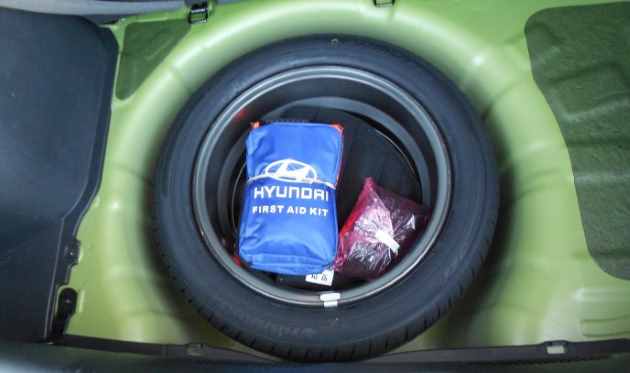Many car manufacturers provide a skinny space saver wheel (a temporary spare tyre) for use if you get a puncture. They save room in the boot which gives you more cargo space, and they weigh less than providing a full-sized spare wheel which gives you better fuel economy. However, because they are designed for temporary use, and because they are not as wide or large as a regular tyre there are some restrictions in using them.
Safe driving on a space saver wheel

Hyundai Accent space saver wheel in the wheel well in the boot
The maximum speed on a space saver is 50mph (80kph) according to European law. However, while some are rated higher (e.g. 80mph), the limit is still 50mph. This is the dry weather speed and if it’s wet you should go slower. The maximum distance you can drive on a space saver tyre is usually marked as around 50 miles (80km) but if necessary they can be driven up to 300 miles (500km) on good surfaces as slow speeds. Preferably, though, the journey will be as short as is possible for you to get to a tyre shop to repair or replace your regular tyre.
Never fit more than one space saver wheel to your car at any time as each space saver reduces your cornering grip by 10-15% and lengthens your braking distance as there’s less rubber in contact with the road. Having a space saver fitted means that you won’t be able to swerve as effectively to avoid an emergency.
When you check the air pressure in your car tyres remember to also check the pressure in the space saver or spare tyre.
Space saver wheels are perfectly safe if you follow the instructions: keep your speed down and don’t drive any further than necessary.
Where should you put your space saver wheel?
If you get a flat front tyre, swap the rear tyre from the same side to the front and put the space saver on the rear. The front wheels are used for turning and (in a front-wheel drive car) transmitting power to the road, so it’s best to have the widest, most grippy tyres possible on the front. However, if you are driving a rear-wheel drive car with a limited slip differential, putting the space saver on the rear can damage the LSD. Put the space saver on the front and keep your speed down, especially if it’s wet, as there will be much less cornering grip. In a regular rear-wheel drive car without a limited slip differential, the space saver should go on the rear, but be aware that you will wheelspin much more easily, and when turning away from the side of the space saver (i.e. it is on the outside of the curve) take care with acceleration out of corners.
The problem you might have is where to put the tyre you have just taken off your car. If you have sports car there’s a chance that it won’t fit in the boot, particularly if you already have some luggage in there. It could be wet and dirty and will almost certainly be covered in black brake dust.
Changing a front wheel puncture
- Cars only come with one jack and it’s highly unlikely you’ll have an axle stand out on the road, therefore the process to change the tyre is:
- Put the handbrake on and put a chock (something like a stone or brick) behind the front wheel on the opposite corner of the car to prevent it moving.
- Jack up the rear of the car, take the tyre off and replace it with the space saver. If you haven’t put the handbrake on, the wheel will turn as you try to undo the lug nuts.
- Put the space saver or spare wheel on and tighten up the lug nuts one by one, making sure that the wheel is seated properly. Don’t over-tighten them.
- Lower the car, recheck the lug nuts on the rear tyre, then move the chock to the rear wheel on the opposite side of the car.
- Before you jack up the car, loosen the lug nuts slightly on the front wheel otherwise it’ll turn when jacked up. Jack up the front and finish undoing the lug nuts.
- Take the punctured tyre off and replace it with the good tyre from the rear.
- Tighten up the lug nuts as much as you can, making sure that the tyre is seated correctly. Then lower the vehicle and finish tightening up the lug nuts.
- Replace the hub cap and ensure it’s on tight otherwise it’ll come off while you’re driving.
- You’ll probably have a lot of brake dust on your hands at this point. Brake dust is really difficult to get off fabric, so clean your hands up as much as you can before touching the upholstery in your car, or your clothes.
You are more likely to get a puncture in wet weather because sharp items on the road are lubricated by the water and can enter the tyre more easily.
Purchasing a replacement tyre
It’s important to get your tyre replaced as soon as possible. If you’re driving in a rural area with coarse road surfaces then the space saver won’t last as long. If possible, call some tyre shops and see what they have in stock that could replace the punctured tyre, or even whether it’s possible to repair the puncture. For example, if it’s just a nail through the middle of the tread, this can often be repaired.
If you have a can of tyre sealant as well as the spare tyre, you could use this on your original flat tyre and you’ll also get another 30-50 miles out of that.
